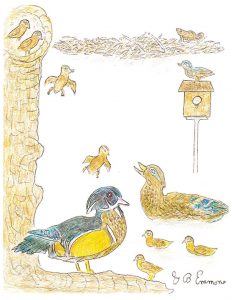The wood duck is a cousin of the Asian Mandarin duck with an inherited oriental and iridescent plumage, red eyes, and a distinctive white flare down the neck. The less colorful female has a whitish throat, but with a crested head like the male.
Color in nature is not just a means of concealment. Most male birds benefit by brighter plumage than their mates, perhaps to put on a show to impress them at the time of courting.
They both have crested heads and are classified as perching ducks with sharp claws for climbing and perching on trees. They usually nest high up in a hollow opening of a tree 20 feet or more, to discourage predators from getting from seven to twenty-five eggs that only incubate for about thirty days.
Amazingly enough, a day or two after hatching, the mother calls to them to climb to the edge of the nest entrance and jump to the ground, preferably over water to soften the impact of landing since they are unable to fly yet. The mother does not help them in any way, and they already know how to swim and look for food.
They feed by dabbling and walking on land and mainly eat berries, acorns, seeds, and insects, making them omnivores. In temperate regions, they may nest more than once in a season before migrating south for the winter.
The population was in serious decline in the late 19th century due to habitat loss and market hunting for meat and plumage for the ladies hat market in Europe. Next to the mallard, the wood duck was and still is the most hunted duck in America.
After the Migratory Bird Treaty Act of 1918, numbers began to recover slowly by ending unregulated hunting and implementing measures to protect remaining habitats. The development of the artificial nesting box gave a big additional boost to convenient production. Also, the return of the beaver population with their industrious work ethic building dams and creating wooded swamps, ponds, and widening streams, greatly increased the wood duck’s feeding and nesting habitat.
Often the nesting boxes appear to be unused, and a recent tagging study by U.S. Fish and Wildlife Service shows they are more likely to take occupancy in boxes that they pass on their way south, remembering them on the way back.
If you have ever seen the remarkable spectacle of ducklings jumping down from a tree nest a day after hatching in a beaver pond, as in my illustration, it may well be an unforgettable impression as it was for me. And it may be a lasting imprint in the survival of species from predation that makes them more comfortable for them and entertaining for bird watchers.
By George B. Emmons
